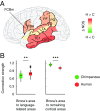Evolutionary expansion of connectivity between multimodal association areas in the human brain compared with chimpanzees
- PMID: 30886094
- PMCID: PMC6452697
- DOI: 10.1073/pnas.1818512116
Evolutionary expansion of connectivity between multimodal association areas in the human brain compared with chimpanzees
Erratum in
-
Correction for Ardesch et al., Evolutionary expansion of connectivity between multimodal association areas in the human brain compared with chimpanzees.Proc Natl Acad Sci U S A. 2019 May 7;116(19):9680. doi: 10.1073/pnas.1906107116. Epub 2019 Apr 29. Proc Natl Acad Sci U S A. 2019. PMID: 31036634 Free PMC article. No abstract available.
Abstract
The development of complex cognitive functions during human evolution coincides with pronounced encephalization and expansion of white matter, the brain's infrastructure for region-to-region communication. We investigated adaptations of the human macroscale brain network by comparing human brain wiring with that of the chimpanzee, one of our closest living primate relatives. White matter connectivity networks were reconstructed using diffusion-weighted MRI in humans (n = 57) and chimpanzees (n = 20) and then analyzed using network neuroscience tools. We demonstrate higher network centrality of connections linking multimodal association areas in humans compared with chimpanzees, together with a more pronounced modular topology of the human connectome. Furthermore, connections observed in humans but not in chimpanzees particularly link multimodal areas of the temporal, lateral parietal, and inferior frontal cortices, including tracts important for language processing. Network analysis demonstrates a particularly high contribution of these connections to global network integration in the human brain. Taken together, our comparative connectome findings suggest an evolutionary shift in the human brain toward investment of neural resources in multimodal connectivity facilitating neural integration, combined with an increase in language-related connectivity supporting functional specialization.
Keywords: chimpanzee; comparative connectomics; connectome; evolution; multimodal.
Copyright © 2019 the Author(s). Published by PNAS.
Conflict of interest statement
The authors declare no conflict of interest.
Figures




References
-
- Berwick RC, Friederici AD, Chomsky N, Bolhuis JJ. Evolution, brain, and the nature of language. Trends Cogn Sci. 2013;17:89–98. - PubMed
-
- Seyfarth RM, Cheney DL. The evolution of language from social cognition. Curr Opin Neurobiol. 2014;28:5–9. - PubMed
-
- Rilling JK. Comparative primate neuroimaging: Insights into human brain evolution. Trends Cogn Sci. 2014;18:46–55. - PubMed
-
- Holloway RL, Sherwood CC, Hof PR, Rilling JK. Evolution of the brain in humans—Paleoneurology. In: Binder MD, Hirokawa N, Windhorst U, editors. Encyclopedia of Neuroscience. Springer; Berlin: 2009.
Publication types
MeSH terms
Grants and funding
LinkOut - more resources
Full Text Sources

